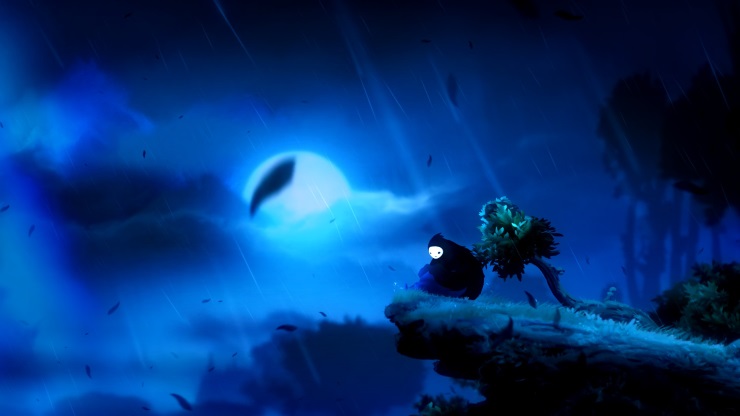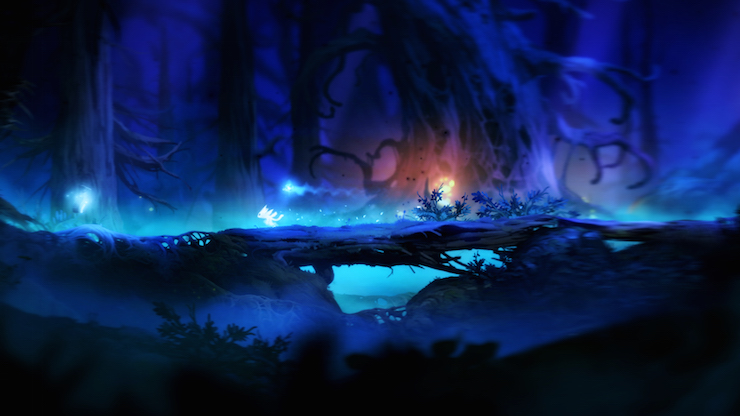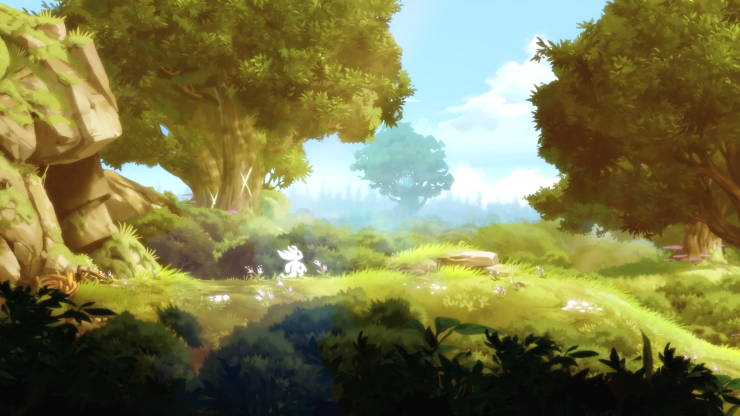Ori and the Blind Forest Review
I don’t cry, as a general rule. I didn’t cry at the end of The Green Mile, or when Gandalf told Aragorn and company to fly, or when Joel suffered tragedy during the opening moments of The Last of Us. I didn’t even cry when Rachel got off the plane. But the first five minutes of Ori and the Blind Forest almost got me, despite there not being a word of spoken dialogue or a single human character.
It tells the story of the titular Ori, a cute little forest spirit fostered by the kindly, rotund Naru. Together they frolic among the hills and high meadows of the great forest, in the light of the Spirit Tree, until their idyllic existence is turned upside down when a terrible storm ravages the forest, all but destroying the Spirit Tree and plunging Ori’s world into darkness. The opening is heart-wrenching and genuinely affecting, but it’s only the first of several moments when Ori grabs you by the aortic pump and won’t let go.

Stranded and alone, Ori is quickly hunted by Kura, a colossal, demonic owl that seems to hate the last vestiges of light to which Ori clings. Guided by Sein – a little orb that represents all that remains of the Spirit Tree’s energy – Ori must evade Kura and restore the three elements of Waters, Winds, and Warmth to save his home.
It’s a story about pluck, as much as anything, as Ori stands up to challenge after challenge, steadily growing stronger and braver as the world only gets more and more deadly. As a “Metroidvania”, the onus is on exploration, light puzzle-solving, and progression. The more skills you unlock, the more places you can reach and manipulate, which in turn allows you to earn more power-ups to discover even more new abilities and areas.
If Ori and the Blind Forest had to be described by comparison, Rayman Origins would spring to mind, albeit with a much darker, more emotional tone. Like the armless wonder, Ori’s greatest strength is mobility. Double and triple jumps, gliding, climbing, bouncing from walls and blasting enemies with soul flames are all in the repertoire, and around a third of the way through you’ll unlock “bash”, which allows you to slingshot through enemies, projectiles and some light sources to stay airborne for long periods of time, or smash through otherwise impassable barriers.

At times, it seems that Ori has almost too many abilities, and juggling them together can be tricky – but only until you become used to them, at which point you realise just how well-crafted a platform game this is. If anything lets it down, it’s the slightly inconsistent pacing. Insanely challenging difficulty spikes pepper the campaign, most notably immediately after you acquire any of the three elements and must then escape the area. Each of these runs can be done in two or three minutes, but there are no checkpoints, and death from any of the numerous, tightly-packed hazards is often instantaneous. As a result, trial and error is unavoidable. To give you some perspective, I finished the game with a 98% completion score in almost exactly ten hours, and died 604 times. That’s a little over one death per minute, and I fluked a fair bit of the game.
But the difficulty itself isn’t the issue, as it can be overcome with perseverance – and I’m not even the most patient player. The problem is that there’s a wonderful cinematic flow to Ori and the Blind Forest, and the sudden spikes of rage-inducing toughness break the immersion and disrupt the pace – particularly as the best moments are found when you’re simply exploring; revelling in Ori’s wondrous sense of motion.
The story is so involving that you’ll feel Ori’s plight, share the dread of Kura and the determination to keep going – and it’s a testament to the incredible level design that exploring the massive map feels effortless. It’s also completely seamless, as even deaths require no loading times – which is a major boon, as you will die a lot. Everything in the forest wants to kill Ori, which is where the unique checkpoint system comes into play. There are only around half a dozen fixed save points in the world, but Ori can use the energy of Sein to create a Soul Link anywhere that’s safe and make a checkpoint. It often makes progression slow and steady – and it’s hell if you forget to save for a long period and then blunder into a trap – but it’s a great system nonetheless.

Hand-drawn and lovingly crafted, the world of Nibel is enormous but, impressively, none of the environmental assets are reused. Each area is unique, and even the lighting and shadows have individual behaviours for the different flora and fauna. Mesmerisingly beautiful and washed over with a dreamlike haze, Nibel most resembles the vibrant world of Trine 2, all sharply contrasting colours and breathtaking interplays of light and dark. The dramatic score is inspired, too, raising the pulse and firing the blood when it needs to, but plumbing staggering emotional depths when the story takes its darker turns.
Ori and the Blind Forest is a masterpiece – of that there is no question. Stunningly pretty and fiendishly clever, it’s ten hours of arguably the most precise puzzle-platforming I’ve experienced – and it pulls on the heartstrings more than most big budget titles can manage. Its only shortcoming is the inconsistent difficulty and the effect that has on the overall pacing. That one gripe aside, Moon Studios’ odyssey is an exceptional adventure that demands to be played and perfected. Simply extraordinary.
PC version also tested.

